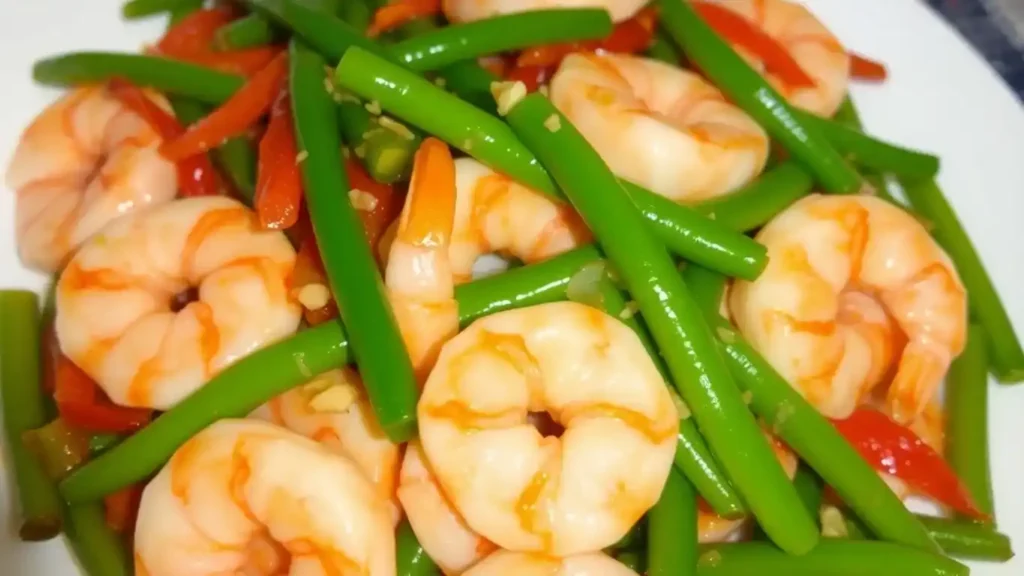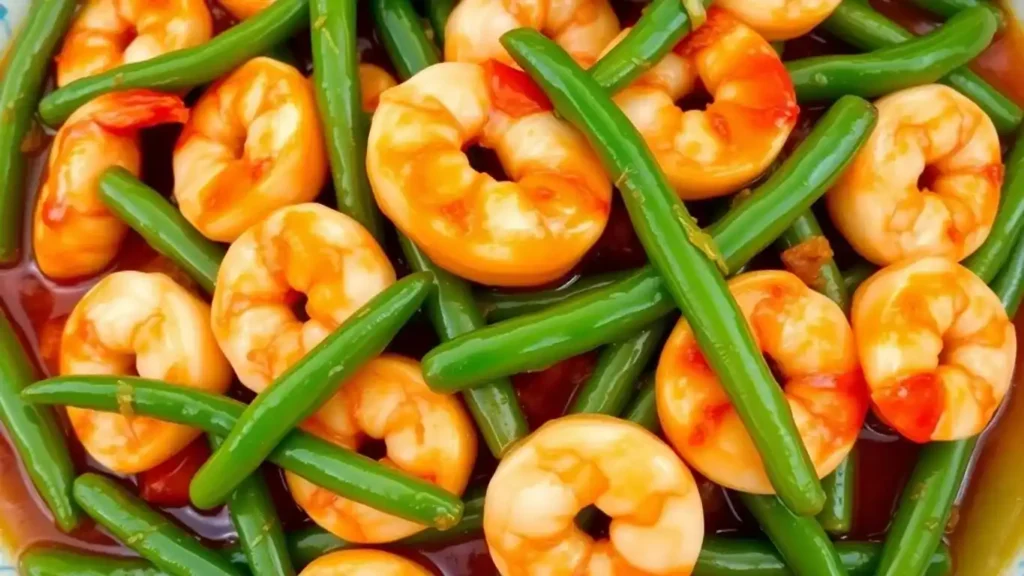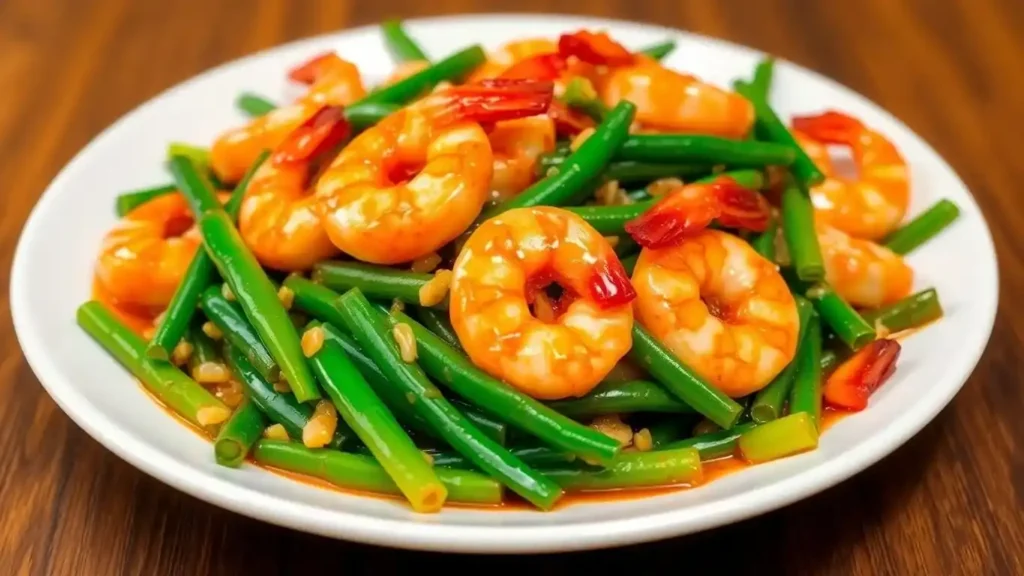Understanding the Ingredients for Chinese Shrimp and Green Beans
Choosing Fresh Shrimp for the Best Flavor
When it comes to shrimp, freshness is key. You want to look for shrimp that have a clean, ocean-like smell. Avoid any that smell overly fishy, as this indicates they’re past their prime. If you’re buying frozen shrimp, make sure they’re individually quick-frozen to maintain their texture. Fresh or frozen, the shrimp should be firm and translucent for a savory Chinese Shrimp and Green Beans Dish.
Selecting the Right Green Beans
Green beans should be bright in color and snap easily when bent. If they look dull or feel limp, it’s best to pass. Try to choose beans that are uniform in size for even cooking. Remember, fresh green beans will give your dish that perfect crunch.
Essential Sauces and Spices
Chinese cooking often relies on a balance of flavors, and this dish is no exception. A good homemade stir fry sauce can be made with soy sauce, ginger, and sesame oil. Adding black pepper gives a subtle heat, while a splash of water helps blend everything together. Keep these staples on hand to whip up a easy Chinese Shrimp and Green Beans.
Preparing Your Kitchen for Cooking Easy Chinese Shrimp and Green Beans
Gathering Necessary Cooking Tools
Before diving into the cooking process, make sure you have all the essential tools at hand. A well-prepared kitchen sets the stage for an enjoyable cooking experience. Here’s a quick list to get you started:
- Wok or Large Skillet: Ideal for stir-frying shrimp and green beans.
- Sharp Knife: For precise cutting and chopping.
- Cutting Board: A sturdy surface to prepare your ingredients.
- Measuring Spoons and Cups: To ensure accurate seasoning.
- Mixing Bowls: Handy for marinating shrimp and mixing sauces.
Setting Up Your Cooking Station
Arrange your kitchen space so everything is within easy reach. This means:
- Placing your wok or skillet on the stove.
- Keeping your utensils like spatulas and tongs nearby.
- Positioning your ingredients in order of use.
- Having a trash bowl for easy cleanup.
Cooking is all about rhythm. When your station is organized, you can focus on the flavors and textures of your dish rather than searching for a misplaced tool.
Organizing Ingredients for Efficiency
Having your ingredients prepped and ready can make the cooking process smoother and more enjoyable. Here’s how:
- Pre-measure sauces and spices: This prevents scrambling for ingredients mid-cooking.
- Wash and trim green beans: Ensure they’re clean and ready to go.
- Peel and devein shrimp: This step is crucial for maintaining the texture and taste.
By organizing your kitchen and ingredients, you set yourself up for a successful cooking session. With everything in its place, you’re ready to create a delightful medley of shrimp and green beans that balances textures and flavors.
Step-by-Step Cooking Instructions

Sautéing Green Beans to Perfection
Start by heating a bit of oil in a wok over medium heat. Toss in the green beans and give them a good stir. Cover the wok and let them steam for about 3 to 5 minutes. If you like them softer, let them go a bit longer. This cooking technique ensures the beans keep their vibrant color and crisp texture.
Cooking Shrimp for Optimal Texture
Now, let’s move on to the shrimp. Coat them lightly with cornstarch for that extra crispiness. In the same wok, add a touch more oil and fry the shrimp on medium heat. It should take about 2 to 3 minutes per side. Once they’re nicely pink and cooked, set them aside. This step is crucial in the cooking process to avoid overcooked shrimp.
Combining Ingredients for a Flavorful Dish
With both the shrimp and green beans ready, it’s time to bring everything together. Heat a little more oil, and sauté some garlic and scallions until fragrant. Add in soy sauce and stock, and let it simmer for a minute. Now, toss the shrimp back in, followed by the green beans. Stir everything well and let it cook for another 3 to 5 minutes until the sauce thickens. This method is inspired by Bangladeshi home cooking, where flavors meld beautifully over medium heat.
Cooking is a journey of flavors, textures, and aromas, where each step builds upon the last to create something truly satisfying. Enjoy each moment in this culinary adventure.
Enhancing Chinese Shrimp and Green Bean with Additional Flavors

Incorporating Spicy Elements
For those who enjoy a bit of heat, adding chili peppers or pepper flakes can really spice things up. Consider using a pinch of cayenne pepper for a subtle kick or try Kashmiri pepper for a vibrant color and mild spice. If you’re feeling adventurous, toss in some sliced jalapeños or even a dash of chili crisp to bring a whole new dimension to your dish. Remember, the key is to balance the spiciness so it complements rather than overpowers the shrimp and green beans.
Balancing Sweet and Savory Tastes
Striking the ideal harmony between sweet and savoury flavours can transform your meal into a memorable dinner. A splash of soy sauce mixed with a hint of sugar or honey can enhance the natural flavors of the shrimp. You might also try adding a bit of grated ginger or a dash of rice vinegar to round out the taste. Don’t forget to season with salt to taste, as this can make a significant difference in bringing out the flavors.
Adding Garnishes for Extra Zest
Garnishing your dish not only adds visual appeal but also enhances the overall flavor. Consider topping your shrimp and green beans with freshly chopped scallions or cilantro. A sprinkle of crispy fried onions can add a delightful crunch. For a touch of freshness, add a squeeze of lime juice or some lemon zest. These small additions can elevate your dish, making it not just a meal, but an experience.
Serving Suggestions for Chinese Shrimp and Green Beans
Pairing with Rice or Noodles
When it comes to serving your beans with shrimp recipe, rice is a classic choice. White rice is a staple, providing a neutral base that lets the vibrant flavors of shrimp and green beans shine. If you’re feeling adventurous, try buttery rice or basmati rice for a fragrant twist. Brown rice adds a nutty flavor and extra fiber, while cauliflower rice keeps it low-carb. For a noodle option, ramen or udon can soak up the delicious sauces.
Creating a Balanced Meal
To balance the meal, consider adding more veggies like broccoli or snap peas. These can be steamed or stir-fried alongside the shrimp and green beans. You could also include a side of sautéed mushrooms for an earthy depth. A splash of fish sauce or a drizzle of sweet chili sauce can enhance the dish’s complexity.
Presentation Tips for a Stunning Dish
Presentation is key to making your dish appealing. Arrange the shrimp and green beans over your choice of rice, ensuring the colors pop. Garnish with a sprinkle of sesame seeds or chopped scallions for added texture and color. A wedge of lime on the side can offer a fresh zing that complements the savory flavors. Serve on a large platter for a family-style meal, or plate individually for a more refined touch.
For a truly memorable meal, focus on the balance of flavors and textures. The combination of tender shrimp, crisp green beans, and a savory sauce over a bed of rice or noodles creates a dish that’s both satisfying and visually appealing.
Troubleshooting Common Cooking Issues
Avoiding Overcooked Shrimp
Cooking shrimp can be tricky. Overcooking them turns them rubbery and unappetizing. To ensure they stay tender and juicy, keep an eye on the heat level. Start with medium-high heat and adjust as needed. Shrimp cook quickly, so as soon as they turn pink and opaque, they’re done. Remember, residual heat will continue to cook them even after removing from the pan.
Maintaining Crisp Green Beans
Green beans should be vibrant and crisp, not mushy. To achieve this, blanch them before sautéing. This process involves boiling them for a short time, then cooling them quickly in ice water. This stops the cooking process and helps retain their color and texture. When sautéing, use medium-high heat to prevent them from steaming in their own juices.
Adjusting Seasoning to Taste
Seasoning is subjective, and getting it just right can be a challenge. Start with a basic seasoning of salt and pepper, then taste and adjust. If the dish feels flat, a splash of soy sauce or a sprinkle of chili flakes can add depth. Keep in mind that heat distribution affects how flavors develop, so stir frequently to ensure even seasoning.
Cooking is about balance. The right heat, the perfect seasoning, and a bit of patience can turn a simple dish into something extraordinary. Don’t be afraid to experiment with heat and seasoning to find what works best for you.
Exploring Variations of the Recipe

Experimenting with Different Vegetables
Trying out different veggies can add a new twist to your shrimp and green beans. Consider swapping green beans for asparagus or broccoli. These veggies hold up well to stir-frying and soak up flavors nicely. Plus, they add a nice crunch to the dish. You can also mix in some bell peppers for a pop of color and sweetness.
Trying Alternative Protein Sources
If shrimp isn’t your thing, don’t worry. You can easily substitute it with chicken, tofu, or even beef. Each of these proteins will bring a unique taste and texture to the dish. Just make sure to adjust your cooking time accordingly, as some proteins might need a bit longer to cook.
Adapting for Dietary Preferences
For those looking to make the dish vegetarian or vegan, tofu is a great replacement for shrimp. You can also explore using tempeh or seitan. Adding a bit of agar agar can help replicate the texture of shrimp. Don’t forget to tweak the seasoning to suit your taste—sometimes a touch of sugar can balance out the flavors perfectly.
Playing around with different ingredients not only makes cooking fun but also helps you discover new flavors and textures. Remember, cooking is all about experimenting and finding what works for you.
Wrapping It Up
And there you have it, folks! Cooking Chinese-style shrimp and green beans is not only quick but also super satisfying. With just a few simple ingredients and steps, you can whip up a dish that’s bursting with flavor. Whether you’re a fan of spicy or prefer it mild, this recipe is flexible enough to suit your taste. Plus, it’s a great way to get some greens into your meal. So next time you’re in the mood for something tasty and easy, give this a try. Happy cooking!
Frequently Asked Questions
What type of shrimp should I use for this recipe?
It’s best to use fresh or frozen shrimp that is already peeled and deveined to save time. You can use any size, but adjust cooking time accordingly.
Can I use other vegetables instead of green beans?
Yes, you can swap green beans with vegetables like broccoli, bell peppers, or snow peas. Just adjust the cooking time to ensure they are tender.
How do I make the dish less spicy?
To reduce the spiciness, you can use less Sriracha or omit the red pepper flakes. Adjust these ingredients to suit your taste.
Can I prepare this dish in advance?
While it’s best enjoyed fresh, you can prepare the sauce and chop the vegetables ahead of time. Cook everything just before serving for the best taste.
What can I serve with shrimp and green beans?
This dish pairs well with steamed rice, noodles, or even cauliflower rice for a low-carb option.
How do I avoid overcooking the shrimp?
Cook the shrimp until they turn pink and opaque, which should take about 2-3 minutes per side. Be careful not to overcook, as they can become rubbery.
